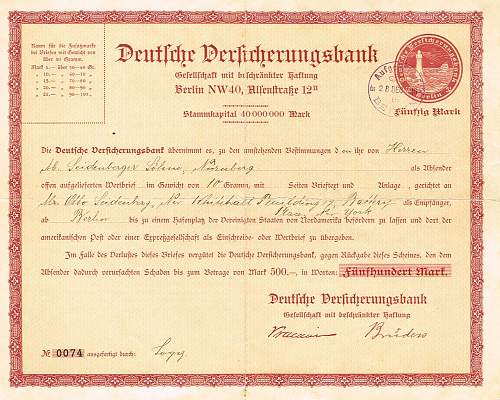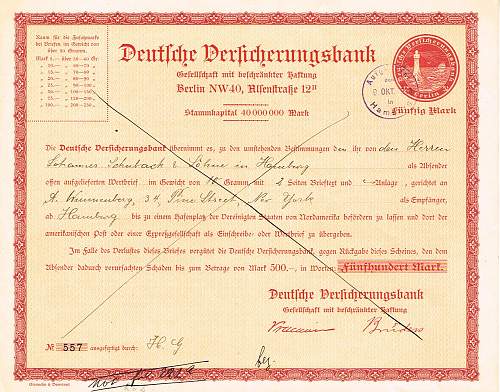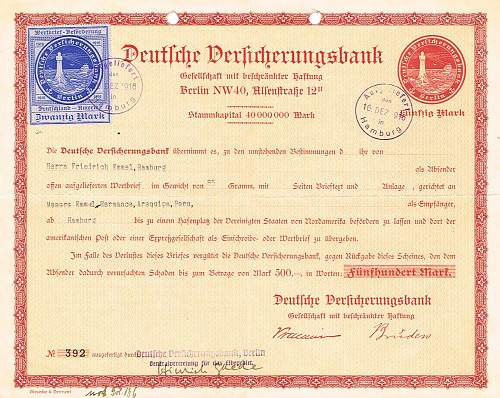Cargo Submarine U-Deutschland Artifacts and Model
Article about: Steve: Thanks for the follow-up on Mont Alto. It looks like Prusse was probably the engineer superintendent of construction on both the Deutschland and the Bremen. His official designation i
-
09-30-2019, 09:18 AM
#1101
-
10-01-2019, 02:27 AM
#1102

spitace41; that is a nice catch with very sharp detail . That is one of the nicest examples I have ever seen. Dwight
-
10-01-2019, 08:42 AM
#1103


by
drmessimer

spitace41; that is a nice catch with very sharp detail . That is one of the nicest examples I have ever seen. Dwight
Coming from you Dwight, I take that as quite a compliment! 
-
12-03-2019, 05:19 PM
#1104


As a new member to the War Relics Forum, I would like to enter my first thread to the Cargo Submarine area with some introductory explanations. My interest in the story of the U-Deutschland came from two seemingly unrelated areas. I come from a family of service to the U.S. Navy with a paternal grandfather who served in the navy in World War I, a father who served in the Pacific during World War II and my service on board a U.S. destroyer in the 1970’s. I have always had a great interest in U.S. Naval History of World War’s I and II. As a stamp collector, in addition to collecting U.S. stamps, I have collected stamps from Germany and in particular the British Occupation issues of the former German Colonies. After I acquired my first copy of one of the stamp issued by the German Insurance Bank, the so called “light house” stamps, I began researching the origin of these colorful stamps. This led me to the history of the U-Deutschland and its remarkable voyages. So in the threads that I will post, I will focus on the Insurance Certificates and the supplemental stamps, the abandoned plan to send regular mail from the Central Powers overseas by the Cargo Submarines and submit scans of the letters with the various cachets and censor markings. In addition, if there is further interest, I will provide postcards of the U-Deutschland and other World War I German Submarines with interesting stories as well as postcards of individuals associated with German Submarines development. Hopefully these relics of history will be of interest.
The definitive resource concerning the submarine transportation of mail between Germany and the United States during World War I is German Submarine Mail of World War I by Bernard A. Hennig, German Philatelic Society Handbook No. 10, 1991. This monograph is my primary source of information about this subject.
The Deutschland departed Bremerhaven for its first voyage on June 14, 1916 via Helgoland arriving at Baltimore, Maryland on July 8, 1916 and returned home on August 25, 1916. There was no official mail transported during the first voyage, but any mail carried by the crew would have been posted in the U.S. mail system. There have been several letters identified from the U.S. that were delivered to the Foreign Office in Berlin for affixing the proper German postage.
By the time the second voyage of the Deutschland was planned, the Deutsche Ozean Rhederei was organized to transport valuable and strategic materials to the U.S. There were no regular letters from Germany aboard the second voyage, but valuable letters and materials were covered by the German Insurance Bank. Insurance certificates were issued with permission of the Secretary of the Interior of the German Reich on August 15, 1916. There were two issues of these Insurance Certificates.
In the scan, is an example of a type I insurance certificate number 0074, which is without an additional stamp since the weight of the item shipped was 10 grams and additional postage was needed only for letters over 50 grams. The rate block on the left of the certificate indicates, “room for supplemental stamps for letters weighing over 50 grams.” There were 200 of type I insurance certificates issued and 1000 of type II issued. These letters and packages were only accepted by the German Insurance Bank in Berlin and its branches in Bremen and Hamburg. The scanned certificate was stamped “Accepted” 28 Dec 1916 in Berlin for destination New York City.
-
12-03-2019, 07:34 PM
#1105

Thomas: Welcome aboard. I am looking forward to your future posts since this is a topic that has not been addressed here. What sort of thing did these certificates cover? Dwight
-
12-04-2019, 01:17 AM
#1106

Dwight:
After the success of the first voyage of U-Deutschland, the Deutsche Ozean Rhederei made plans to handle shipments of "strategic" and "valuable" materials. According to Hennig's monograph this included insuring letters and packages of value. Once these items reached the U.S., those with mailing addresses in the U.S. were placed in new envelopes or wrappings and then forwarded within the U.S. by the U.S. Post Office as registered mail or by the American Express using their equivalent of registered mail.
-
12-04-2019, 01:24 AM
#1107
-
12-04-2019, 09:37 PM
#1108

In preparation for the second voyage of the Deutschland to the U.S., the Deutsche Ozean Rhederei issued adhesive stamps to be affixed to the insurance certificates when additional charges were needed according to the weight of the letter or parcel. These stamps were cancelled by the German Insurance Bank in Berlin or at its branches in Bremen or Hamburg. The insurance certificates were imprinted with a 50 Mark insurance stamp in the upper right corner which covered the first 50 grams of weight of the letter or parcel. The adhesive stamps were used for items weighing over 50 grams.
These stamps were also printed in blocks of four stamps by Giesicke and Devrient of Leipzig, Germany. In the first issue of stamps, 1000 were printed of the 5 Mk, and 500 each of the 10, 15, 20, 25, and 50 Mk. In the second issue, 500 were printed for the 5-50 Mk., and 300 of the 75 Mk., and 200 of the 100 Mk. It is estimated by the German Insurance Bank that half of the stamps and certificates were used to forward letters by the Deutschland and Bremen. The remaining examples were returned to the Berlin office of the German Insurance Bank following the loss of the Bremen. There are examples in stamp collections of unused insurance stamps, cancelled stamps on insurance certificates, and cancelled insurance removed from the insurance certificates.
Examples of the cachet of cancellations used to cancel the insurance certificates and the adhesive stamps used on these certificates. These cancellations were not performed by the German Post Office but rather by the German Insurance Bank

-
12-05-2019, 12:02 AM
#1109

Thomas; do you know what sort of "stuff" or "things" were in the envelopes and packages? Dwight
-
12-05-2019, 05:10 AM
#1110

Dwight:
I do not know specifically what was contained in the insured packages or parcels. It is inferred from Hennig's monograph that some of the materials were official matters to German Consulates or to the interred German naval ships in Baltimore. There were postings to South America such as Peru and to Haiti. There were many to New York, New York addresses, but the contents were not disclosed. Thanks, Tom.
Similar Threads
-
In SS Uniforms and insignia
-
In Imperial Germany and Austro-Hungary
-
In Non-Combat Uniforms and related insignia of the Third Reich
-
In Battlefield history and relics
-
 Posting Permissions
Posting Permissions
- You may not post new threads
- You may not post replies
- You may not post attachments
- You may not edit your posts
-
Forum Rules




 .
.







Bookmarks